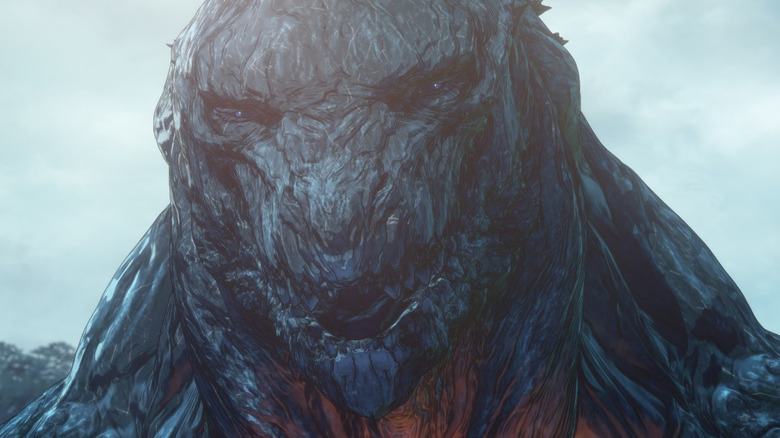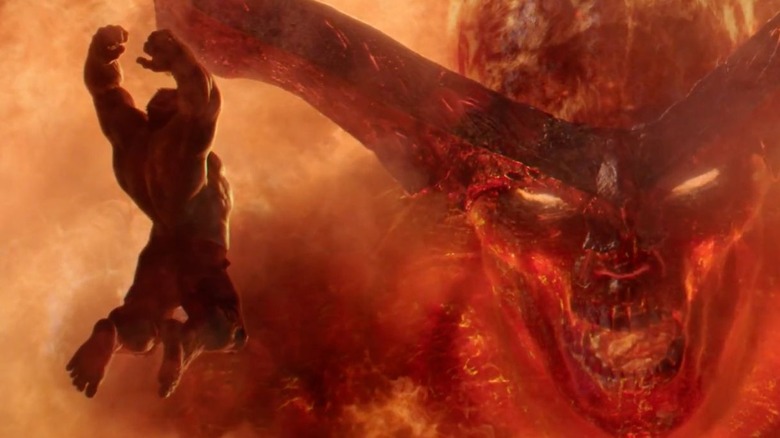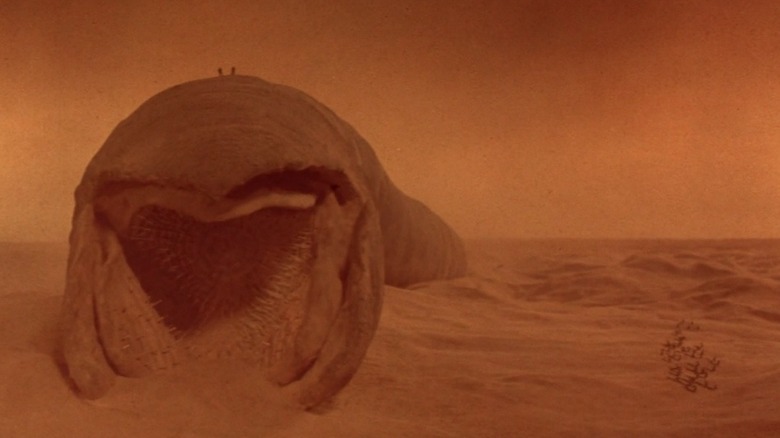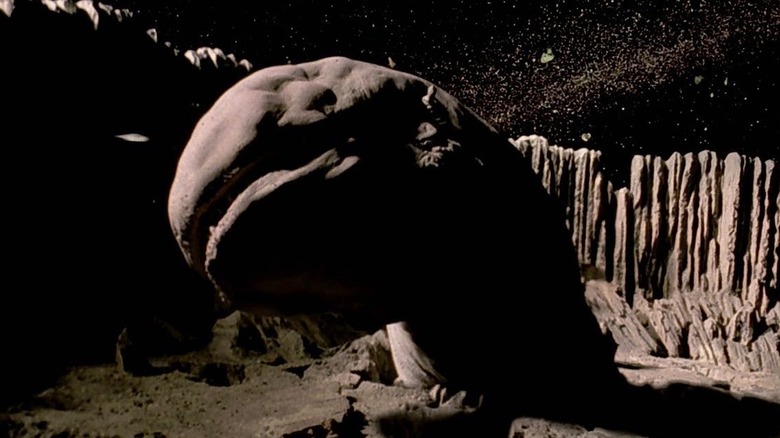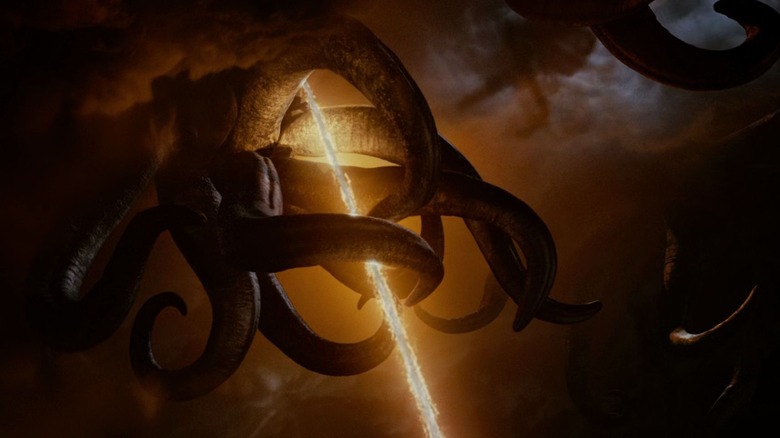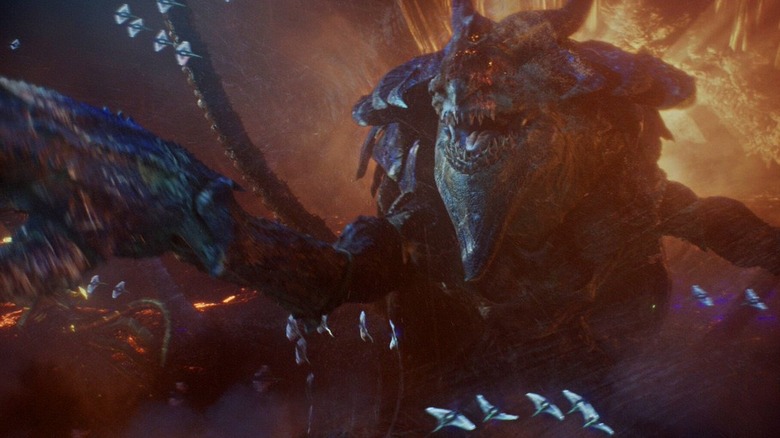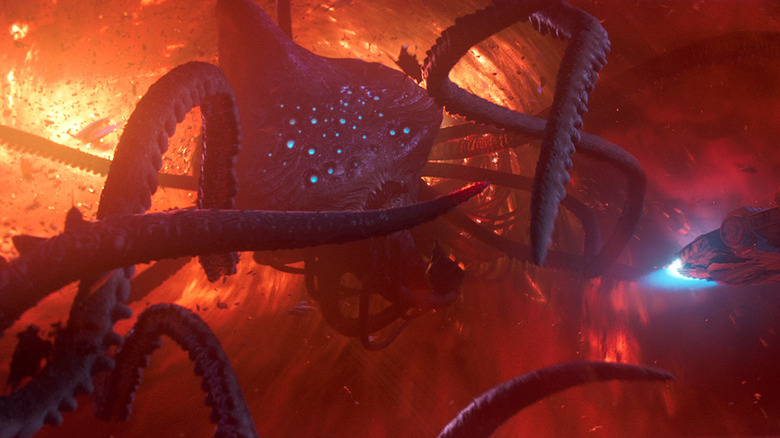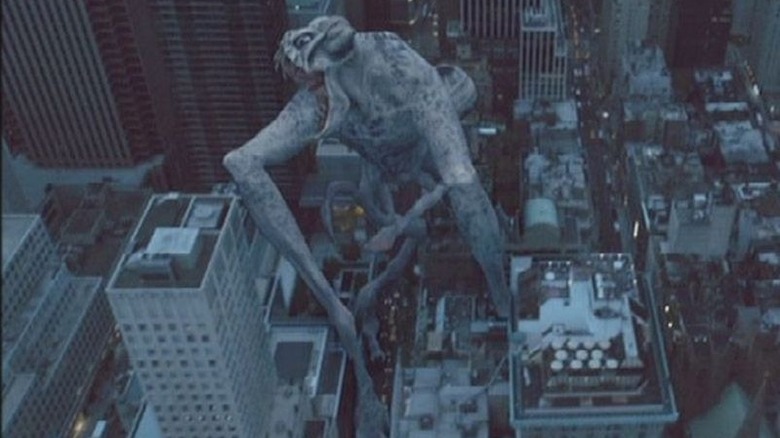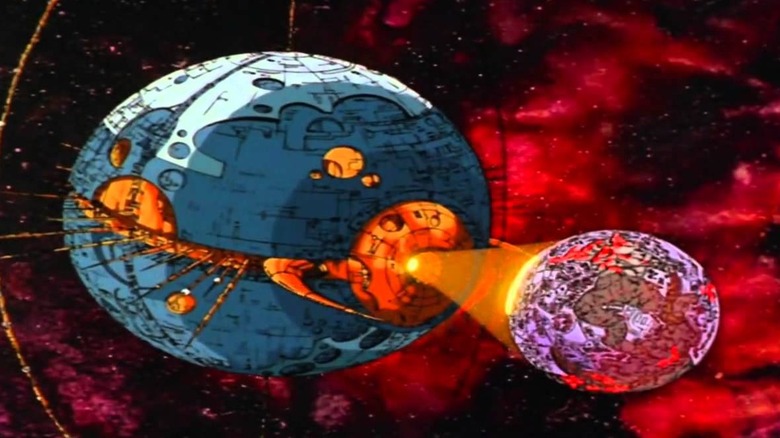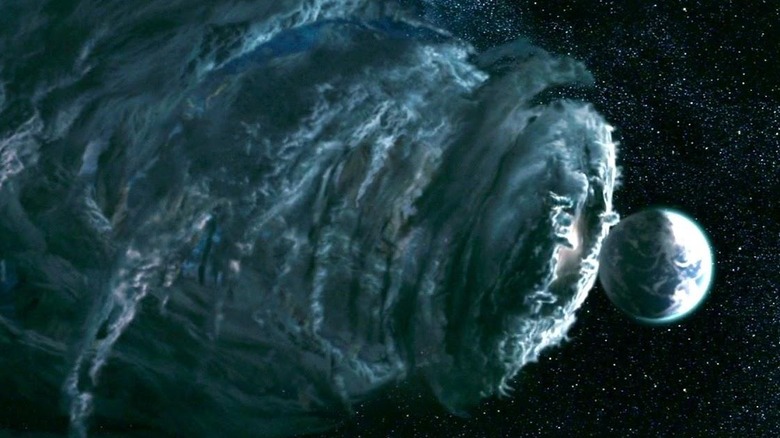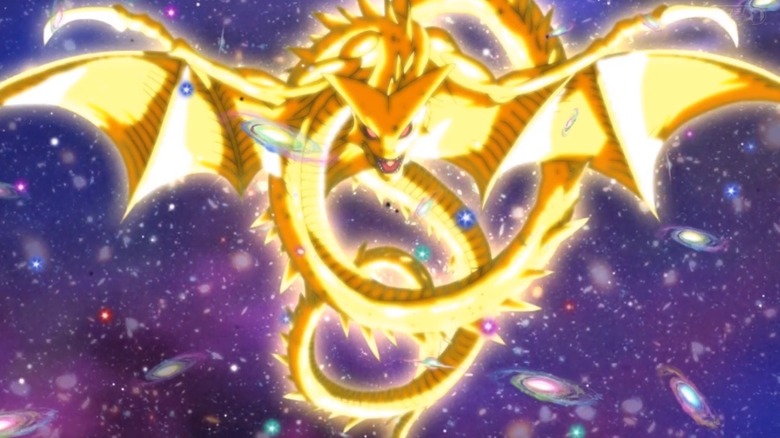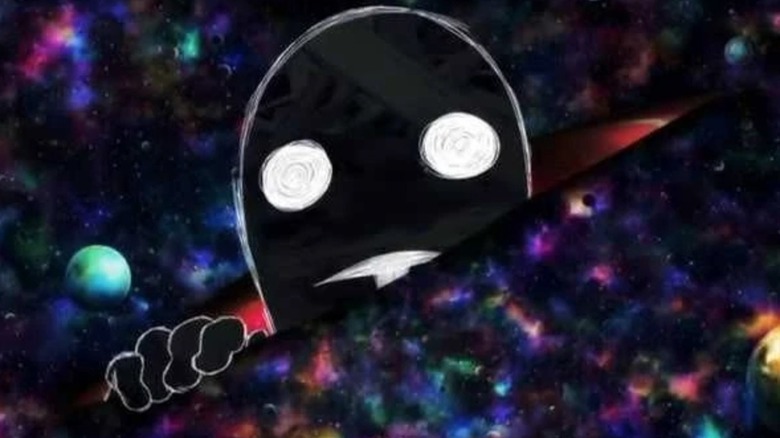Monsters That Are Way Bigger Than Godzilla
Describe Godzilla in one word. And no, "giantradioactivedinosaurthatbreathesnuclearfire" isn't one word. You probably thought of "big," right? More than anything — more than his spikes, radioactivity, aggressive personality, or penchant for punching three-headed space dragons in the face(s) — people worldwide know Godzilla is big. Even "Godzilla" (1998), which is so unlike Godzilla in every conceivable way that fans have dubbed him GINO (Godzilla in Name Only), was promoted with the slogan Size Does Matter.
So how big is Godzilla? Depends. Godzilla's size varies based on the filmmaker's vision. During the Showa Era of films (1954-1975) he was 50 meters, or about 164 feet tall, his "smallest" version, which would still be the tallest and biggest animal to ever live. However, Showa-Zilla is smaller than a bunny next to Godzilla's biggest version — the 300-meter/ 984-foot Godzilla Earth from Netflix's anime series, "Godzilla: Monster Planet."
Godzilla may be King of The Monsters, but he's certainly not the biggest monster. Not by a long shot. There are many monsters from movies and TV that make even Godzilla Earth look puny. Sure, fans may be estimating on some sizes, but there's no denying: They're much bigger than The Big G. Now, just because they're bigger, we still believe Godzilla would find a way to beat them, even if some are so insanely massive they make Godzilla smaller than a quark by comparison. Size does matter, and these behemoths prove it. Here are monsters that are way bigger than Godzilla!
Surtur was so big he caused Ragnarok
Surtur was the Big Bad in "Thor: Ragnarok." Make that very Big Bad. As the Herald of Ragnarok, Surtur was the Fire Giant who turned Asgard into ash. You better believe no shorty is going to end all life as we know it; this dreadful demon of destruction definitely buys his shirts at Big and Tall. Surtur's height fluctuates (a benefit of being a space demon we guess), so he starts "Thor: Ragnarok" at about 15 feet tall, more than tall enough to play center for the Lakers, though not quite kaiju size. Thor defeated, or least contained, this shorter form of Surtur early in the film, before realizing he couldn't stop his evil sister Hela on his own, but Surtur could.
So Thor "broke glass in case of evil psychotic sister" and placed Surtur's crown atop the Eternal Flame, resurrecting the fire god and transforming him to his final form, with a height of more than 1,000 feet according to fan estimates. Besides being taller than Godzilla, Surtur is mightier than Thor, with powers of telekinesis, immortality, and the manipulation of the Eternal Flame and cosmic energy. He's so powerful he took a full-throttled Hulk Smash right to the face like it was nothing more than a mosquito bite and destroyed an entire planet by plunging his fire saber into the ground, which is pretty metal if you ask us.
Dune's massive sandworms are pretty spicy
The only thing more memorable than the Texas Longhorn burnt-orange haircut Sting was sporting in David Lynch's 1984 adaptation of "Dune" were the massive sandworms, which plagued the principal characters before becoming slithering saviors. Born from the imagination of novelist Frank Herbert for his 1965 Hugo Award-winning sci-fi opus of the same name, sandworms are the predominant species of the planet Arrakis. For you "Tremors" fans, they're basically big Graboids. Much like Bugs Bunny, you can see sandworms coming from miles away by their trail in the ground. Unlike Bugs Bunny, they never took a wrong turn at Albuquerque and always arrived at just the right time to cause the most amount of mayhem.
Despite being destructive, sandworms weren't all bad. They were critical to the creation of spice, the MacGuffin of Herbert's masterwork that was used to power interplanetary travel and intergalactic commerce, and also give people a trip straight out of Woodstock '69. While seeing a sandworm and living to tell the tale is extremely rare, they are highly allergic to water. Even a Super Soaker's worth of H20 to sandworms is like salt to a slug, so it's super convenient that they live on a desert planet. In the film, Dr. Wellington Yueh said sandworms got up to 400 meters (or almost 1,500 feet), while some legends said they got as big as 1,000 meters (3,280 feet). Your granny definitely wouldn't want these guys in her tomato garden.
The Exogorth struck back in Empire
The original "Star Wars" trilogy is filled with exotic critters that are never described or even named on screen — they just show up to fill your imagination with wonder (a far cry from pop culture today with fans who insist everything gets an explanation). One such critter was the Exogorth, the giant space slug that lived in an asteroid and nearly swallowed the Millennium Falcon in "Star Wars: The Empire Strikes Back."
If your only experience with Exogorths is the one from "The Empire Strikes Back," well buckle up, because you don't know the half of it. Exogorths aren't just dumb space slugs, but are sentient creatures that actually can house entire ecosystems inside their bodies. Exogorths asexually reproduce, splitting off into exact replicas when they reach full maturity. If an Exogorth doesn't split, they could grow as big as the one in "Empire," which was about 900 meters according to fan estimates, or just shy of 3,000 feet in length.
The Ogdru Jahad gave Hellboy hell
We considered including H.P. Lovecraft's Cthulhu on this list, but except for a silent short film from 2005 he/it is more prolific in memes rather than movies. So we opted for a more cinematic substitute — the Lovecraftian "old gods" from "Hellboy." The Ogdru Jahad, as they're called in the film and the comic books it was based on, are the Big Bads of "Hellboy" and direct the dastardly Rasputin from their crystal shells in outer space. From there they hope to be resurrected by Hellboy using his Right Hand of Doom to unlock them and instigate Ragnarok, or the end times.
Thankfully, Hellboy comes back to his senses before the squid-like baddies can wreak havoc on Earth, but not before they unleash one of their 369 offspring (ever heard of birth control, y'all?) — the massive, multi-tentacled monstrosity, Behemoth. While Behemoth is certainly big, Hellboy manages to stop Squidward's revenge by letting loose grenades in its gut after getting swallowed by the monster. That certainly sounds unpleasant, but Godzilla had a freaking nuke blow up in his face, so Behemoth would be no problem for the Big G. The Ogdru Jahad may be another story: While we never got an official height in the film, they appear to be at least a couple of miles in length.
The Karathen was queen of the seas
Long after filling the hills with "The Sound of Music," Julie Andrews also filled the seas with the sound of sheer terror as the voice of the Karathen in "Aquaman." You might say this was a "bigger" role (we're not above shameless dad jokes). According to the 2018 DCEU blockbuster, the Karathen is an ancient sea monster who was originally believed to be a villain imprisoned by Aquaman's ancestor, King Atlan, but was actually a loyal guardian who protected King Atlan's trident for millennia from those who were unworthy of wielding it.
Aquaman was able to telepathically communicate with the Karathen and enlist her help in his fight for Atlantis with his evil half-brother, which was super convenient. The Karathen looks like a cross between a giant shrimp, squid, and dragon, which besides making the world's biggest shrimp boil (you're going to need a lot of butter), also makes her a powerful ally. She's also seriously big, about two miles in length, or 10,560 feet. This means that the world's fastest human, Jamaican sprinter Usain Bolt, whose top speed was clocked at 27.33 miles per hour, would still take more than four minutes to run across her going at full speed. Not that he would want to ... look at that thing.
The summa-verminoth may be Star Wars' biggest monster
The "Star Wars" franchise is no stranger to massive monsters, from the 45-meter/147-foot long Krayt Dragon in "The Mandalorian", to the 100-meter/328-foot tall Sarlacc pit monster in "Return of the Jedi", to the 200-meter/656-foot long Sando sea beast in "The Phantom Menace," all the way up to the 900-meter/3,000-foot Exogorth in "Empire Strikes Back." Yet the biggest of the bunch so far is the summa-verminoth in "Solo: A Star Wars Story." If you think the Exogorth is big, then the summa-verminoth look like the Exogorth ate the Exogorth...times four.
This gargantuan, multi-tentacled, Cthulhu-like creature lived among stars in the Akkadese Maelstrom, the celestial storm that surrounded the planet Kessel. At an estimated 7,432 meters or 24,383 feet wide, the summa-verminoth could grow to be more than 4.6 miles long. That's about the distance between the Empire State Building and Wall Street. Thankfully, Han Solo survived his run-in with this massive beast early in his career and then the Exogorth about 10 years later, only to be slayed by his traitorous emo son Kylo Ren. What can you do?
The Cloverfield monster had its head in the clouds
The monster in 2008's "Cloverfield" appears to be between 250 and 300 feet tall, about on par with the tallest versions of Godzilla. So Clover (as the monster has been affectionately dubbed by fans) would give The King of the Monsters some trouble, but would definitely be seafood to the Big G. However, Clover in "Cloverfield" was actually a baby. Yes, a 300-foot tall baby. Must have been a difficult birth. The adult is much bigger. Like, freaky big. While the adult is only glimpsed for a few seconds at the end of 2018's "The Cloverfield Paradox," it is big enough that its head reaches above the clouds.
That would make the adult Clover at least 6,500 feet tall, or a little over one mile, according to fan estimates. That's at a minimum, as the highest clouds, the noctilucent clouds, can get as high as 43,000 feet or eight miles. While the adult Clover is probably somewhere in between the two extremes, he's at least 7.2 times as tall as Godzilla Earth's 984-foot frame and at most 47 times taller. For context, that's about the height difference between a 6-foot tall man and a 1.5-inch mouse. When it comes to going crazy with monster sizes, Clover's creators went almost as hard as Phil Collins did when he wrote the "Tarzan" soundtrack.
Unicron is a planet-sized robot in disguise
"Transformers" boasts that they are "robots in disguise" but it's pretty hard to disguise the Big Bad of the entire series, Unicron. Sadly, Unicron is not a giant unicorn, but a devourer of worlds who goes by many titles: "The Lord of Chaos," "The Chaos Bringer," "The Planet Eater," and "Yeezy" (we made up that last one). How does a giant robot get so big? Why by consuming everything, of course: moons, planets, stars, even the whole of creation itself. Basically us during the weekend special at Golden Corral. Unicron is also a master of manipulation, which seems kinda redundant when you can consume entire galaxies, but whatever.
Since he is a Transformer after all, he is able to change from a humanoid robot form to a giant planet-eating ... well ... planet. Sorry if you were hoping his robot form was a giant semi-truck in space, which really seems like a missed opportunity. Unicron's twin brother is his arch-enemy Primus, a benevolent god who created the Transformers to take Unicron out. Unicron first appeared in the animated "Transformers: The Movie" in 1985, with fans estimating his Generation 1 height at about 10,000 km, almost twice the size of Earth. Believe it or not, Michael Bay actually went smaller for once, but only for the sake of a big twist. Turns out Unicron appeared in all of the Bay movies, as "Transformers: The Last Knight" revealed Unicron was Earth. Now that's an impressive disguise.
Galactus' size is pretty fantastic
Galactus is the OG planet eater from the Marvel Universe. While the purple one (no, not Prince) has been a part of Marvel Comics since the mid-1960s, his presence in the movies has been a bit cloudy. Literally. Galactus' first live-screen cinematic appearance, in 2007's "Fantastic Four: Rise of the Silver Surfer," was as a giant cloud of swirling space debris large enough to swallow the Earth. While Galactus' familiar big-horned form is briefly seen, he is blown to smithereens by the Silver Surfer, so we don't know how big he is exactly.
In the comics, Galactus usually looks to be no more than 50 feet, so he'd barely be able to look over Godzilla Earth's big toe, though his numerous powers and floating space fortress more than make up for his vertical impairment. Galactus may be that "small" in "Fantastic Four: Rise of the Silver Surfer," with the sinister space cloud simply being his surroundings, but we're not sure, so we'll give the big guy the benefit of the doubt. So how big is Galactus in the movie, then? Well, big enough to swallow the Earth, so at least as big as Uranus.
Super Shenron is an unbelievably big space dragon
Godzilla's no stranger to fighting golden space dragons, as his arch-nemesis is the three-headed monster, Ghidorah. Ghidorah's height fluctuates almost as much as Godzilla's, but he's always big. His smallest version was 164 feet in "Godzilla, Mothra and King Ghidorah: Giant Monsters All-Out Attack," while his largest was in the anime "Godzilla: Planet Eater," when he was more than 20 kilometers, or 12.4 miles long. Alas, being a Godzilla monster, Ghidorah didn't qualify for this list. Even if he did, he still wouldn't be the biggest space dragon on this list. Not even close. The biggest space dragon in fiction is Super Shenron from "Dragon Ball Z." Super Shenron's name means "Super Divine Dragon" or "Super Dragon God" so there's no ambiguity there, and he appears whenever the Super Dragon Balls are gathered.
Super Shenron's powers are basically without limits, including resurrecting people and even universes that have been wiped from existence. However, he only grants one wish per appearance, so you better make it a good one, like: "Please make HBO re-do the eighth season of 'Game of Thrones'" or something. While Super Shenron appears in several different "Dragon Ball Z" timelines, he's insanely big in each of them. How big? Like the size of a big planet? Not even close. Super Shenron is shown to be bigger than millions of galaxies, so basically the size of the observable universe. Conveniently, he can shrink his size, presumably so he can fit in those uncomfortable airplane seats.
The Anti-Spiral is too big to even imagine
Of course the biggest monster on this list is from anime. Enter The Anti-Spiral, the main bad guy of "Tengen Toppa Gurren Lagann." The Anti-Spiral is the leader of the Anti-Spiral race and the physical manifestation of their consciousness. You'd think a race of brilliant deities could dream up a more imposing consciousness than a solid black slender man, but guess not. Shocking no one, The Anti-Spiral is a huge jerk. Keyword: Huge.
Stay with us here: During the series' final battle, the Anti-Spiral occupies a mech known as the Granzemboma. When the titular Tengen Toppa Gurren Lagann mech upgrades to its super-size form, the Anti-Spiral mech matches its height. The result? A titanic throwdown between two inconceivably big mechs. How big? Oh, about 52 billion light years, according to fan estimates. What?! To give that context, the observable universe is 46 billion light years across in all directions. Yes, the Anti-Spiral is 6 billion light years bigger than the universe. That's not only a bigger difference than the Milky Way galaxy (a measly 200,000 light-years across), but our Local Group of galaxies (10 million light-years). If you were traveling at the speed of light, it would take you 52 billion years (3.8 times the age of the universe) to get from The Anti-Spiral's toe to the top of his head. So yeah, the dude definitely has to slouch on the subway. Still, we think Godzilla could take him.
